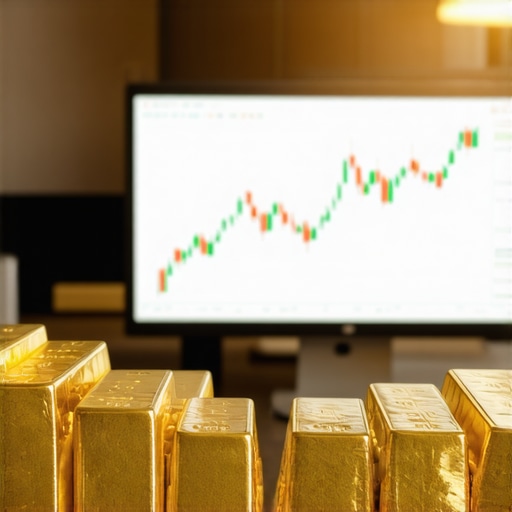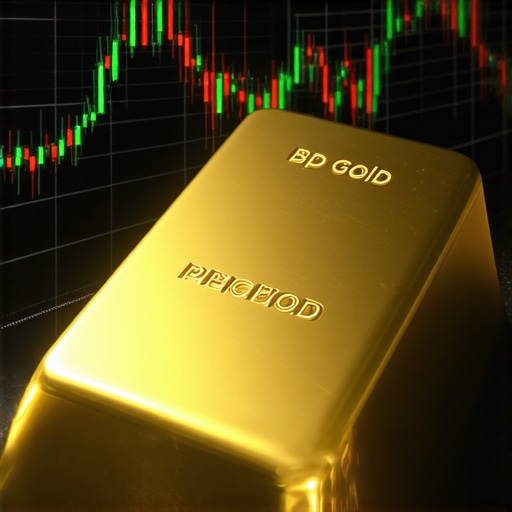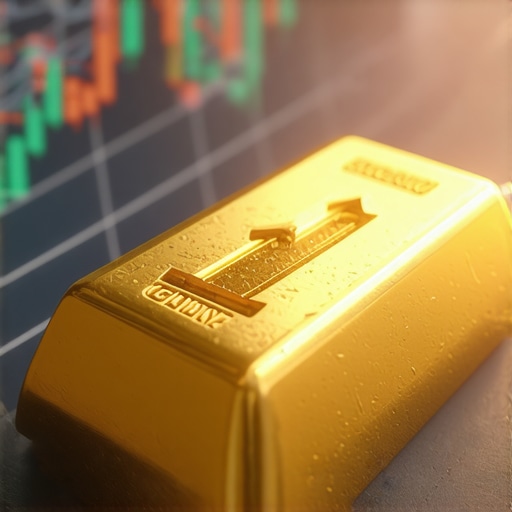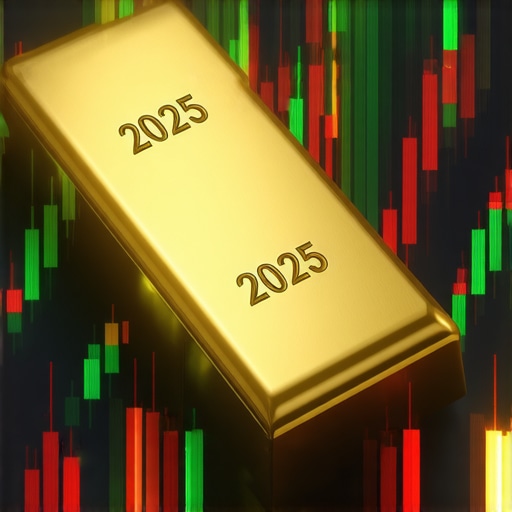Exploring Gold Price Trends: Key Factors Influencing Market Fluctuations
Gold has long been regarded as a vital asset in the world of investing, providing a safe haven during economic uncertainties and a hedge against inflation. For beginners stepping into the realm of gold investment, understanding the dynamics of gold price trends is essential. This knowledge not only helps in making informed investment decisions but also in anticipating market movements. In this article, we will delve into the various factors that influence gold prices and how these trends can affect your investment strategies.
The Role of Supply and Demand in Gold Pricing
At the core of any market, including that of gold, lies the principle of supply and demand. When demand for gold increases, prices typically rise. Conversely, an oversupply can lead to falling prices. Several factors can affect demand, including industrial use, consumer habits, and investment trends. For instance, during periods of economic instability, many investors flock to gold as a store of value, driving up demand and prices.
To gain deeper insights into how to navigate these trends, consider exploring 2025 Gold Market Dynamics: Key Factors for Investors. This resource provides valuable information on the current market landscape.
Global Economic Indicators and Their Impact on Gold Prices
Global economic indicators such as inflation rates, currency strength, and geopolitical tensions play a significant role in shaping gold prices. For example, when inflation rises, the purchasing power of currency typically declines, making gold an attractive alternative. Additionally, fluctuations in the value of the U.S. dollar can influence gold prices. A weaker dollar usually correlates with higher gold prices, as gold becomes cheaper for investors using other currencies.
Moreover, understanding how these economic indicators interact with gold pricing can enhance your overall investment strategy. For further reading, check out Key Factors Influencing Gold Price Dynamics in 2025, which explores these relationships in greater detail.
Central Bank Activities and Their Effects on Gold Markets
The actions of central banks around the world can significantly impact gold prices. When central banks increase their gold reserves, it typically signals confidence in gold as a reliable asset. This can lead to increased demand and subsequently higher prices. Conversely, when central banks sell off gold, it can have the opposite effect. Staying informed about central bank policies can provide investors with critical insights into potential price movements.
For those new to the gold market, understanding these intricacies is crucial. The article How Central Bank Purchases Impact Gold Demand Today offers a comprehensive overview of this topic.
Technological Innovations and Gold Price Trends
Technological advancements also play a role in shaping gold prices. Innovations in mining technology can lead to more efficient extraction processes, affecting supply levels. Additionally, the rise of digital gold platforms and gold-backed cryptocurrencies has introduced new investment avenues, potentially influencing traditional gold price trends. As these technologies evolve, they will likely continue to impact the gold market.
By understanding these various factors and their interplay, new investors can better navigate the complexities of gold investment. To maximize your investment potential, consider reading Maximize Your Profits: Expert Gold Trading Techniques. This resource offers practical strategies to enhance your trading skills.
Geopolitical Factors and Their Influence on Gold Prices
Geopolitical events can significantly impact gold prices, as investors often turn to gold during times of uncertainty. Conflicts, trade disputes, and political instability can create fear in the markets, leading to increased demand for gold as a safe haven asset. For instance, tensions in the Middle East or economic sanctions on major economies can trigger a surge in gold prices as investors seek to protect their wealth.
To stay informed about how geopolitics affect your investments, it’s beneficial to explore resources like Analyzing Gold Market Trends: What’s Next for Investors, which provides a detailed look at current geopolitical influences on the gold market.
The Importance of Investor Sentiment in Gold Pricing
Investor sentiment plays a crucial role in driving gold prices. Market psychology can lead to fluctuations based on perceptions of economic stability or instability. For example, during times of economic growth, investors may choose to invest in higher-risk assets, leading to decreased demand for gold. Conversely, during market downturns, fear and uncertainty can lead to a rush towards gold, driving prices higher.
Understanding this aspect of the market can help you anticipate price changes. For an in-depth look at how sentiment impacts gold investments, consider reading Gold vs. Stocks: Which is the Better Investment for 2025?, which discusses the comparative performance of these asset classes.
The Role of Inflation and Interest Rates on Gold Prices
Inflation and interest rates are critical economic indicators that influence gold pricing. Generally, when inflation rises, the real returns on bonds and savings accounts decrease, making gold a more attractive investment. Similarly, low interest rates tend to decrease the opportunity cost of holding gold, as investors forgo less in interest income by choosing to invest in gold instead. Understanding the relationship between these economic factors and gold can enhance your investment strategy.
For those looking to deepen their understanding, Understanding Gold Price Fluctuations: A 2025 Guide offers valuable insights into how inflation and interest rates specifically affect gold prices.
Market Speculation and Its Impact on Gold Prices
Market speculation can also sway gold prices significantly. Traders often react to market news, economic reports, and changes in the macroeconomic environment, which can lead to volatility in gold prices. Speculators may buy gold futures contracts based on anticipated price movements, which can amplify market trends. Being aware of speculative trends can help investors make informed decisions.
To learn more about how to navigate market speculation, check out Effective Gold Price Forecasting Techniques for 2025, an article that offers strategies to predict price movements based on market signals.
Seasonal Trends in Gold Prices
Another aspect to consider is the seasonal trends in gold prices. Historically, certain times of the year tend to see increased demand for gold, such as during wedding seasons in India or during major holidays when gifts are exchanged. These seasonal patterns can provide investors with unique opportunities to buy or sell gold based on fluctuating demand.
For an exploration of how to leverage these seasonal trends, consider reading Quick Guide: Investing in Gold for Beginners in 2025, which outlines strategies for timing your investments.
Understanding Seasonal Trends in Gold Prices and Their Impact
Seasonal trends are an often-overlooked aspect of gold investment strategies. Awareness of these patterns can significantly influence buying and selling decisions throughout the year. Gold prices often fluctuate based on cultural practices and economic cycles, particularly in countries where gold holds significant cultural value, such as India and China. For example, the wedding season in India typically sees a spike in gold demand, which can lead to increased prices globally.
To gain a comprehensive understanding of how these trends can affect your investments, consider reading Gold Demand Trends: Predictions for the Coming Year. This resource offers insights into how seasonal demand influences price movements.
Key Festivals and Their Effect on Gold Prices
Festivals such as Diwali and Akshaya Tritiya in India create a significant surge in gold purchases. During these times, consumers often buy gold as part of tradition, leading to increased demand and higher prices. Similarly, Chinese New Year prompts a rise in gold buying as people gift gold jewelry and coins to symbolize wealth and prosperity. Investors should be aware of these patterns to make timely investment decisions.
Global Economic Events and Their Correlation with Gold Prices
In addition to seasonal trends, global economic events also play a critical role in determining gold prices. Economic indicators such as employment rates, GDP growth, and international trade agreements can create fluctuations in the market. For instance, announcements of economic sanctions or trade disputes can lead to uncertainty, prompting investors to seek the safety of gold. To understand how these factors might impact your investments, explore 2025 Gold Market Dynamics: Key Factors for Investors.
Climate Change and Its Impact on Gold Mining
Interestingly, climate change is beginning to affect gold supply chains. Extreme weather events can disrupt mining operations, leading to reduced gold production and subsequently higher prices. As environmental issues become more pronounced, investors may need to consider how these factors could impact their gold investments. Understanding the intersection of environmental factors and market dynamics is crucial for forward-thinking investors.
For more insights into how external factors shape the gold market, refer to Analyzing Gold Market Trends: What’s Next for Investors. This article examines the various influences on gold prices and offers predictions for future trends.
Technical Analysis and Predicting Gold Price Movements
Investors can leverage technical analysis to identify patterns and predict future price movements based on historical data. By studying charts and indicators, you can gain insights into past price behavior, which can help in forecasting future trends. This analytical approach is especially useful when combined with an understanding of seasonal trends and global events, creating a comprehensive investment strategy.
For those interested in mastering technical analysis, Effective Gold Price Forecasting Techniques for 2025 provides a solid foundation and actionable strategies for investors.
Market Sentiment and Its Influence on Seasonal Trends
Investor sentiment can also amplify seasonal trends. During major buying seasons, if the market sentiment is positive, it can lead to even higher price surges due to increased buying pressure. Conversely, if sentiment shifts negatively, even during peak seasons, it can cause prices to stagnate or fall. Being attuned to market sentiment and understanding its influence on seasonal buying patterns can provide a competitive edge for investors.
To delve deeper into the psychological aspects of market behavior, consider exploring Gold vs. Stocks: Which is the Better Investment for 2025?, which discusses how investor perceptions shape market dynamics.
Analyzing Seasonal Trends: How Festivals and Economic Events Impact Gold Prices
Understanding seasonal trends in the gold market is crucial for any investor looking to optimize their investment strategy. Gold prices often exhibit fluctuations based on cultural practices, economic cycles, and significant global events. For instance, in countries like India and China, gold holds immense cultural value, leading to spikes in demand during specific seasons. Recognizing these trends can help investors make more informed buying and selling decisions throughout the year.
Major Festivals and Their Influence on Gold Prices
Festivals such as Diwali in India and the Chinese New Year are pivotal events that greatly influence gold demand. During Diwali, gold purchases soar as families engage in traditional buying practices to symbolize prosperity and good fortune. Similarly, the Chinese New Year prompts heightened gold consumption as gifts are exchanged. These cultural practices create a significant surge in demand, often leading to an increase in gold prices globally.
Investors should be well aware of these seasonal buying spikes. To delve deeper into how these cultural events shape price movements, refer to Gold Demand Trends: Predictions for the Coming Year. This article provides insights into the timing and impact of demand surges linked to festivals.
Global Economic Events and Their Relationship with Gold Prices
In addition to seasonal trends, global economic events play a crucial role in determining gold prices. Economic indicators such as employment rates, GDP growth, and international trade agreements can create fluctuations in the market. For example, announcements of trade sanctions or geopolitical tensions can lead to uncertainty, prompting investors to seek the security of gold. Understanding how these factors interconnect with gold prices is essential for making strategic investment decisions.
For those interested in analyzing how global events might impact gold investments, consider exploring Analyzing Gold Market Trends: What’s Next for Investors, which examines the current geopolitical influences on the gold market.
The Impact of Climate Change on Gold Prices
Interestingly, climate change is beginning to impact gold mining operations and consequently the supply chain. Extreme weather events, such as floods and droughts, can disrupt mining activities, leading to reduced gold production and potentially higher prices. As environmental conditions continue to evolve, it is vital for investors to consider how these climate-related factors may affect their gold investments.
To gain insights into how external factors shape the gold market, refer to Analyzing Gold Market Trends: What’s Next for Investors. This resource discusses the various influences on gold prices, including environmental factors and their implications for future trends.
Technical Analysis: Predicting Gold Price Movements
Investors can also utilize technical analysis to identify patterns and forecast future price movements based on historical data. By studying charts, indicators, and past price behavior, you can gain valuable insights that can help in making informed investment decisions. This analytical approach is especially beneficial when combined with an understanding of seasonal trends and global events, as it creates a comprehensive investment strategy.
For those interested in mastering technical analysis, Effective Gold Price Forecasting Techniques for 2025 provides actionable strategies that can aid investors in navigating the complexities of the gold market.
Market Sentiment and Its Role in Seasonal Trends
Finally, market sentiment can amplify seasonal trends. Positive sentiment during peak buying seasons can lead to increased price surges due to heightened demand. Conversely, if sentiment shifts negatively, even during high-demand periods, it can stifle growth in prices. Being attuned to market sentiment, along with understanding its influence on seasonal buying patterns, can provide a competitive edge for investors.
To explore the psychological aspects of market behavior further, consider reading Gold vs. Stocks: Which is the Better Investment for 2025?, which discusses how investor perceptions shape market dynamics and influence gold investments.
Frequently Asked Questions About Gold Prices
What factors influence gold prices the most?
Gold prices are primarily influenced by supply and demand dynamics, global economic indicators such as inflation and interest rates, geopolitical events, and central bank activities. Additionally, investor sentiment and market speculation play significant roles in driving price fluctuations.
How does inflation impact gold investment?
Inflation typically leads to a decline in the purchasing power of money, making gold an attractive investment as it tends to retain its value. When inflation rises, many investors turn to gold as a hedge, driving up its price.
Why do central banks buy gold?
Central banks purchase gold to diversify their reserves and instill confidence in their currency. An increase in gold reserves often signals economic stability and can lead to higher gold prices as demand increases.
What role does investor sentiment play in gold pricing?
Investor sentiment can significantly impact gold prices, especially during times of economic uncertainty. Positive sentiment can lead to increased buying, while negative sentiment may cause investors to sell, thus affecting prices.
How do seasonal trends affect gold prices?
Seasonal trends, particularly in countries like India and China, can lead to significant increases in gold demand during festivals and wedding seasons. These cultural practices often result in higher prices during peak buying periods.
What are the effects of geopolitical tensions on gold prices?
Geopolitical tensions often lead investors to seek safe-haven assets like gold. Events such as conflicts, trade disputes, or political instability can drive up demand for gold, resulting in price surges.
How can I predict gold price movements?
Investors can use technical analysis, which involves studying historical price patterns and market trends, to forecast future movements. Combining this with an understanding of economic indicators and investor sentiment can enhance prediction accuracy.
Are gold-backed cryptocurrencies affecting gold prices?
Yes, the rise of gold-backed cryptocurrencies is creating new investment avenues. These digital assets can influence traditional gold price trends by attracting a new generation of investors who may turn to gold as a store of value.
What is the relationship between gold prices and the U.S. dollar?
Gold prices typically have an inverse relationship with the U.S. dollar. When the dollar weakens, gold becomes cheaper for investors using other currencies, often leading to an increase in demand and higher prices.
How do I effectively invest in gold?
Effective gold investment involves understanding market dynamics, keeping an eye on economic indicators, and recognizing seasonal trends. Diversifying your investment method—such as purchasing physical gold, gold ETFs, or gold stocks—can also enhance your portfolio’s resilience.
Authority Resources for Gold Investors
For those looking to deepen their understanding of gold investment, the following resources are invaluable:
- World Gold Council – A leading authority on gold, providing comprehensive research and insights into the gold market.
- Investing.com – Gold – Offers real-time gold prices, charts, and analytical tools for traders and investors.
- Kitco Metals – Gold News – Provides news, prices, and analysis of gold and other precious metals.
- Bloomberg – Commodities – Features news and updates on commodity markets, including gold.
- Reuters – Commodities News – Offers timely updates and analysis on global commodities, including gold.
Conclusion: Navigating Gold Investment Strategies in 2025
Understanding gold price trends is crucial for effective investment strategies in 2025. By exploring the factors that influence gold prices, including seasonal trends, economic indicators, and market sentiment, investors can make informed decisions. As gold remains a key asset for preserving wealth and hedging against market volatility, equipping yourself with knowledge and resources is essential for successful investing in this precious metal.









